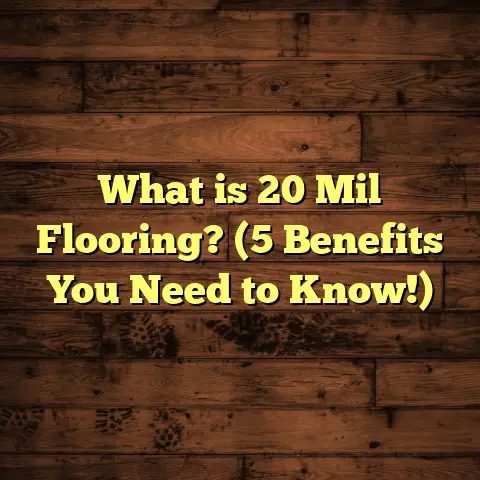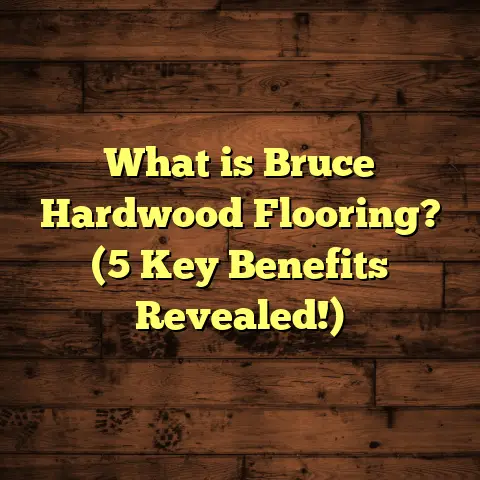What is Vinyl Flooring Made Of? (5 Key Materials Explained)
Vinyl flooring has grown tremendously popular over the past couple of decades. In fact, the global vinyl flooring market size was valued at around $28 billion in 2022 and is projected to grow at a compound annual growth rate of approximately 6% through 2030. This surge is due to vinyl’s affordability, versatility, and durability. But many people still ask me: What exactly is vinyl flooring made of? It’s more than just a plastic sheet on your floor. Over years of installing floors for homeowners and businesses, I’ve learned that understanding what goes into vinyl can help you make smarter decisions — whether you’re a DIYer or hiring pros.
What Is Vinyl Flooring Made Of?
When I first started learning about flooring materials, I was surprised by how much engineering goes into vinyl floors. At its core, vinyl flooring is a synthetic product primarily made from polyvinyl chloride (PVC) along with other essential components that give it flexibility, color, durability, and resistance to wear.
It’s made up of multiple layers stacked together, each serving a different purpose:
- Backing layer
- Core layer
- Printed design layer
- Wear layer (topcoat)
Let’s break down the five key materials that make vinyl flooring what it is.
1. Polyvinyl Chloride (PVC)
PVC is the heart of vinyl flooring. It’s a plastic polymer created by polymerizing vinyl chloride monomers. This material is known for its toughness, chemical resistance, and waterproof qualities.
From my experience working with different brands and grades of vinyl, I can tell you that the quality of PVC varies significantly. Higher-grade PVC has fewer impurities and better molecular structure, which translates to floors that last longer without cracking or fading.
For example, I had a client in Florida who chose a lower-cost vinyl with cheaper PVC content for their coastal home. Within four years, they faced brittleness and cracking due to constant sun exposure and humidity. On the other hand, another client who selected vinyl with high-grade PVC had their floor looking great after over 10 years in a similar environment.
PVC also provides the base flexibility needed for the floor to handle daily foot traffic without breaking or cracking. This flexibility is important for residential floors that may experience shifting subfloors or slight impacts from dropped items.
2. Plasticizers
PVC on its own is rigid and brittle. To make it soft and flexible enough for flooring applications, manufacturers add plasticizers — chemical additives that increase flexibility by embedding themselves between polymer chains.
This addition prevents the vinyl from becoming stiff and cracking over time. The most common plasticizers used are phthalates, but due to health concerns, newer formulations now often rely on non-phthalate alternatives.
I remember an older installation where the vinyl contained outdated plasticizers. After about 8 years, the floor started to harden and crack along edges. Modern plasticizers have improved this greatly.
Plasticizer quality affects not just durability but also indoor air quality. Cheaper plasticizers can off-gas volatile organic compounds (VOCs), which raises health concerns especially in poorly ventilated rooms or homes with kids.
If you’re sensitive to chemicals or want a greener product, look for vinyl labeled as low-VOC or phthalate-free. This has become an important factor for many clients I work with, especially those with allergies or chemical sensitivities.
3. Stabilizers
Stabilizers are added to vinyl formulations to protect the material during production and throughout its use. Vinyl exposed to heat or UV light without stabilizers would degrade rapidly — turning yellow, becoming brittle, or losing strength.
In my years on job sites near large windows or sunrooms, I always recommend vinyl products with strong UV stabilizers. Otherwise, the floor can discolor within months to a couple of years.
Stabilizers can be metal-based (like lead or calcium-zinc compounds) or organic. With lead being hazardous, modern products use safer alternatives but still provide excellent protection.
One client installed vinyl flooring in a sunroom with floor-to-ceiling glass walls. Thanks to high-quality stabilizers in the product chosen, their floor stayed vibrant for well over a decade despite constant sunlight exposure.
4. Pigments and Colorants
The colors and patterns we see in vinyl flooring come from pigments either mixed directly into the vinyl layers or printed onto surface layers using advanced printing technology.
This allows manufacturers to replicate natural materials like hardwood grains, stone veining, or ceramic tile designs almost perfectly.
I’ve helped clients pick out wood-look vinyl planks that fooled guests into thinking the floor was real hardwood — yet it was far easier to clean and maintain.
The pigments used are designed to be fade-resistant and stay true over many years of wear and sunlight exposure.
Here’s an interesting data point: according to a flooring industry study, pigment fade resistance improves by nearly 25% when combined with effective UV stabilizers — a perfect example of how these materials work together for longevity.
5. Wear Layer
The wear layer is a transparent topcoat applied over the printed design layer to protect vinyl flooring from scratches, stains, scuffs, and general wear.
This layer determines how durable the floor will be in daily use — especially in high traffic areas like kitchens, hallways, retail stores, and offices.
Wear layers vary in thickness from as thin as 6 mils (0.006 inches) for residential use up to 20 mils or more for commercial-grade floors.
I always advise clients who want long-lasting floors to select products with a minimum wear layer thickness of 12 mils for homes and 20 mils for commercial spaces.
During one retail store project I managed, choosing a thicker wear layer saved thousands of dollars in premature floor replacement costs after several years of heavy foot traffic.
Some wear layers also have additional ceramic bead reinforcement embedded for extra scratch resistance — something I recommend if you have pets or kids running around.
How These Materials Come Together: The Vinyl Flooring Structure
You might be wondering how all these materials combine into the finished product you walk on every day.
Vinyl flooring comes in several forms:
- Sheet vinyl: Large continuous rolls
- Luxury Vinyl Tile (LVT): Tiles usually 12″x24″ or similar sizes
- Luxury Vinyl Planks (LVP): Long planks mimicking hardwood boards
Each type uses the materials discussed but arranged differently depending on installation method and design goals.
The backing layer is usually made from fiberglass or felt attached beneath the PVC core layer to add dimensional stability and prevent curling.
The core layer contains PVC mixed with plasticizers and stabilizers forming the bulk of the floor’s thickness and flexibility.
On top of this core lies the printed design layer, where pigments create the visual appeal replicating natural textures.
Finally, the wear layer seals everything from above — protecting your floor from damage and wear for years.
Real-World Case Study: Vinyl Flooring in Rental Properties
I’ve worked extensively with property managers who prefer vinyl flooring because it offers a good balance of durability, cost-efficiency, and ease of maintenance — all critical factors for rental units.
In one project managing 50 rental apartments, we installed luxury vinyl planks with:
- 15 mil wear layers
- Low-VOC plasticizers
- UV stabilizers suited for northern-facing units with some direct sunlight
After five years, inspections showed minimal wear — tenants reported easy cleaning even after spills or muddy shoes.
The landlord saved thousands by avoiding costly replacements typical with carpet or hardwood in rentals. Plus, tenants appreciated how warm and quiet vinyl was underfoot compared to tile alternatives.
How Understanding Vinyl’s Materials Helps You Choose Better Products
When clients ask me for advice on picking vinyl floors, I always bring up these material points because they help explain price differences and performance expectations.
Here’s what I usually share:
- Don’t just pick based on appearance; understand the wear layer thickness.
- Ask about types of plasticizers used — safer options prevent health risks.
- Inquire about UV stabilizers if your room gets lots of sun.
- Don’t forget about backing layers — good backing reduces curling.
- Check manufacturer warranties as they often reflect material confidence.
Cost Insights: How I Use FloorTally in My Projects
Estimating costs accurately is one of the most challenging parts of my job. Vinyl flooring pricing varies widely depending on quality and installation complexity.
To keep my budgets tight and realistic, I use an online tool called FloorTally. This platform helps me:
- Calculate material costs based on local prices
- Add labor costs appropriate to my region
- Incorporate waste factors automatically (usually 5-10%) so I don’t order too little
- Compare different material options side-by-side
- Visualize total project cost clearly for clients
Using FloorTally saves me hours each week that I’d otherwise spend crunching numbers manually or chasing quotes from suppliers.
For example, when working on a mid-sized kitchen remodel recently, FloorTally helped me quickly estimate that using LVP with a 12 mil wear layer would cost about $4 per square foot installed — including removal of old flooring and prep work.
Clients appreciate this transparency because they know what they’re paying for upfront without surprises later.
Installation Tips Based on Material Properties
Since vinyl is made from flexible PVC with various protective layers, installation requires certain considerations:
- The subfloor must be clean, level (within 3/16 inch over 10 feet), and dry.
- Sheet vinyl often needs full adhesive coverage; planks or tiles may be click-lock or glue-down.
- Temperature during installation should be stable (65–85°F) because PVC can expand/contract.
- Cutting vinyl requires sharp tools to get clean edges.
- Avoid heavy rolling loads immediately after installation until adhesive cures fully.
I recall a job where improper subfloor prep caused noticeable bumps showing through thin sheet vinyl — costly fix avoided by proper leveling beforehand.
Maintenance Tips: Caring for Your Vinyl Floor Materials
Thanks to its composition, vinyl flooring is pretty low maintenance compared to hardwood or carpet but still needs care:
- Sweep/vacuum regularly to avoid dirt scratching the wear layer.
- Clean spills promptly with mild soap; avoid abrasive cleaners.
- Use felt pads under furniture legs to prevent dents.
- Avoid waxes or polishes that can build up on the wear layer.
- For tougher stains, manufacturer-approved cleaners work best without damaging plasticizers or topcoat.
Over time, maintaining these materials properly keeps your floor looking fresh well beyond warranty periods — saving money on early replacement.
Environmental Considerations of Vinyl Flooring Materials
One question I get often: Is vinyl flooring eco-friendly?
The truth is complex. Vinyl’s PVC base comes from petroleum-based sources which aren’t renewable. However:
- Advances in recycling programs allow some manufacturers to reuse post-consumer vinyl scrap.
- Low-VOC plasticizer formulations reduce indoor pollution risks.
- Some brands offer certifications like FloorScore® proving low emissions.
When selecting flooring for environmentally conscious clients recently, I’ve recommended brands focused on greener practices while maintaining durability standards.
My Personal Takeaway: Why Knowing Vinyl’s Materials Makes a Difference
After installing hundreds of floors over two decades — from budget rentals to luxury condos — I’ve learned that knowing what goes into your flooring helps avoid regrets later on.
Vinyl might look simple at first glance but is actually a sophisticated product engineered from PVC, plasticizers, stabilizers, pigments, and protective coatings working together for comfort and durability.
By understanding these materials:
- You’ll choose better quality products that last longer.
- Avoid cheap knockoffs prone to cracking or fading.
- Make informed decisions balancing cost vs lifespan.
- Know how maintenance affects longevity.
Plus, using tools like FloorTally ensures your budget matches your choices so you never get caught off guard financially during installation projects.
Got any more questions about vinyl flooring materials? Or want me to help you pick out the perfect product? Just reach out! Sharing what I’ve learned over years helps me make sure clients get floors they love without surprises down the road.
(End of Article)





